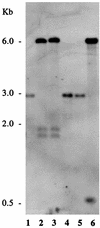Identification and characterization of a determinant (eep) on the Enterococcus faecalis chromosome that is involved in production of the peptide sex pheromone cAD1
- PMID: 10498702
- PMCID: PMC103617
- DOI: 10.1128/JB.181.19.5915-5921.1999
Identification and characterization of a determinant (eep) on the Enterococcus faecalis chromosome that is involved in production of the peptide sex pheromone cAD1
Abstract
Plasmid-free strains of Enterococcus faecalis secrete a peptide sex pheromone, cAD1, which specifically induces a mating response by donors carrying the hemolysin plasmid pAD1 or related elements. A determinant on the E. faecalis OG1X chromosome has been found to encode a 46.5-kDa protein that plays an important role in the production of the extracellular cAD1. Wild-type E. faecalis OG1X cells harboring a plasmid chimera carrying the determinant exhibited an eightfold enhanced production of cAD1, and plasmid-free cells carrying a mutated chromosomal determinant secreted undetectable or very low amounts of the pheromone. The production of other pheromones such as cPD1, cOB1, and cCF10 was also influenced, although there was no effect on the pheromone cAM373. The determinant, designated eep (for enhanced expression of pheromone), did not include the sequence of the pheromone. Its deduced product (Eep) contains apparent membrane-spanning sequences; conceivably it is involved in processing a pheromone precursor structure or in some way regulates expression or secretion.
Figures




References
-
- An, F. Unpublished data.
-
- An F Y, Clewell D B. Characterization of the determinant (traB) encoding sex pheromone shutdown by the hemolysin/bacteriocin plasmid pAD1 in Enterococcus faecalis. Plasmid. 1994;31:215–221. - PubMed
-
- Ausubel F M, Brent R, Kingston R E, Moore D D, Seidman J G, Smith J A, Struhl K, editors. Current protocols in molecular biology. New York, N.Y: John Wiley & Sons, Inc.; 1987.
-
- Barth, P. (Zeneca Pharmaceuticals). Personal communication.
Publication types
MeSH terms
Substances
Associated data
- Actions
Grants and funding
LinkOut - more resources
Full Text Sources
Other Literature Sources
Molecular Biology Databases

